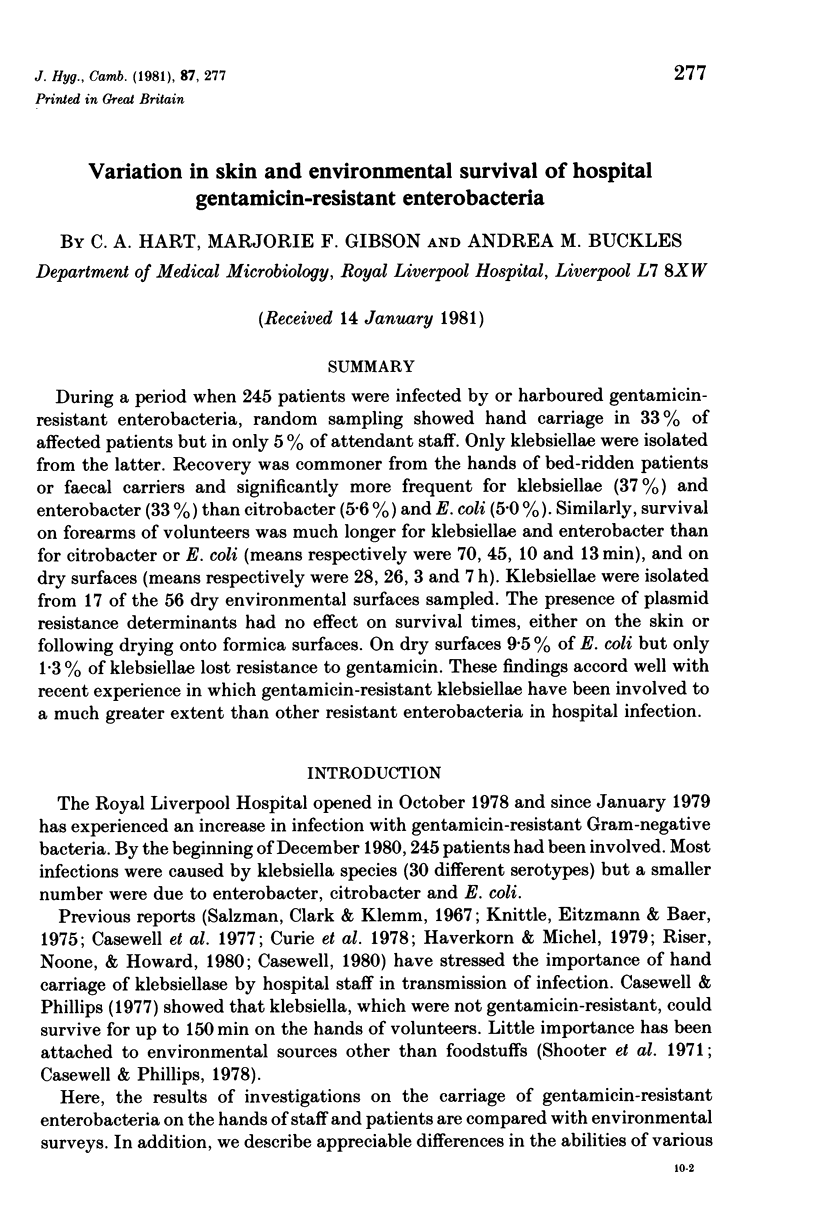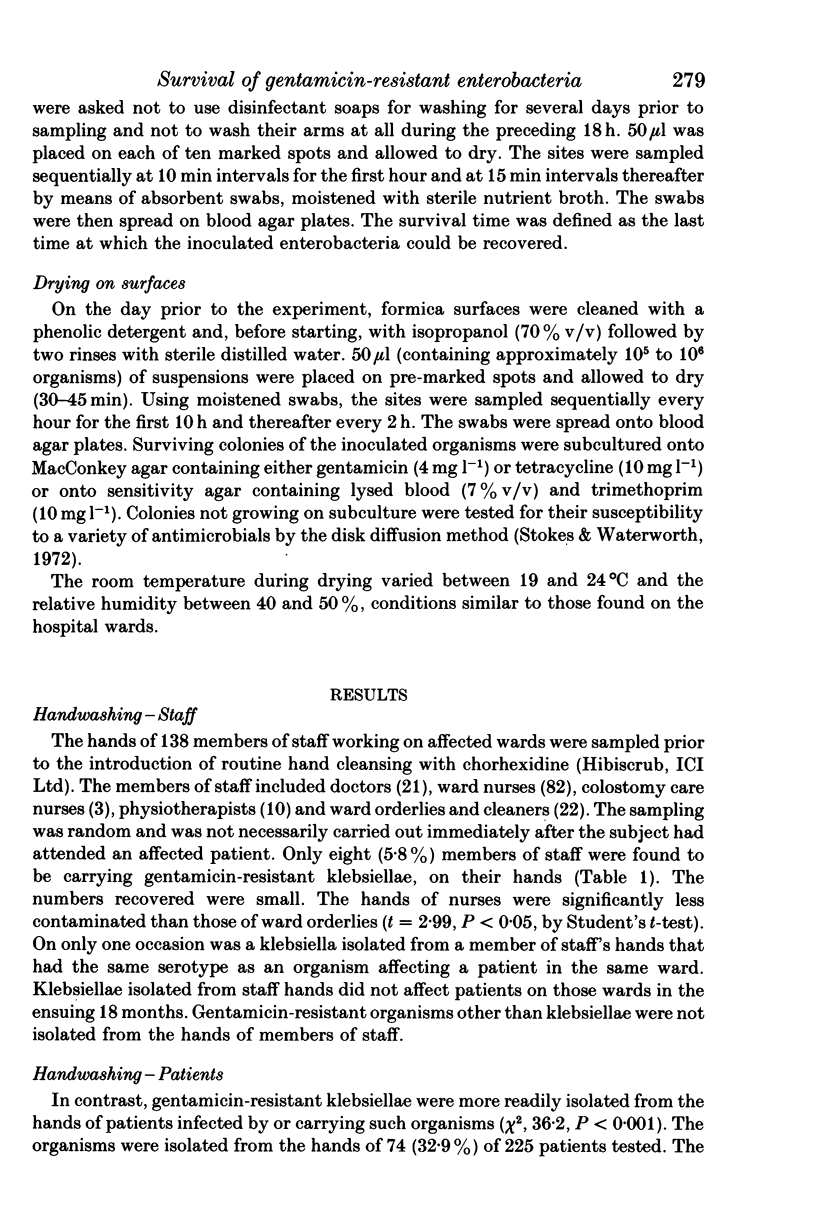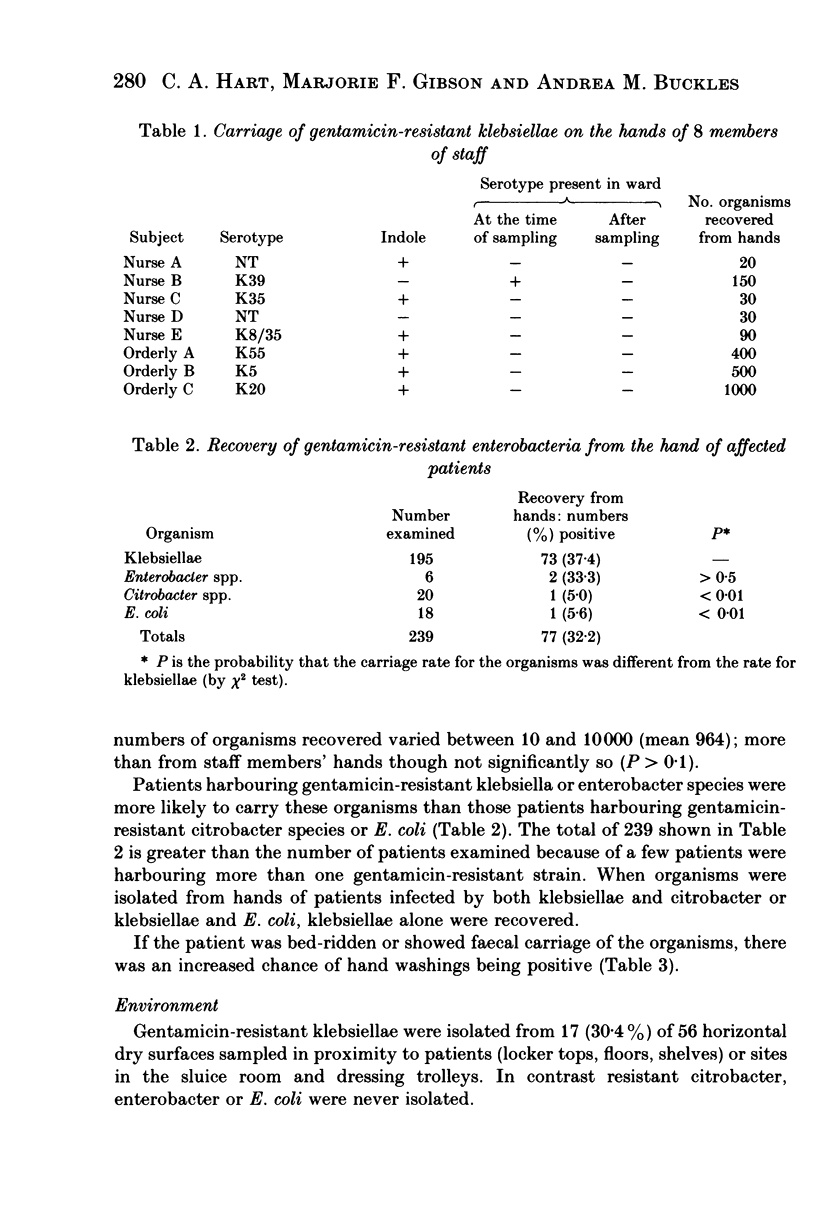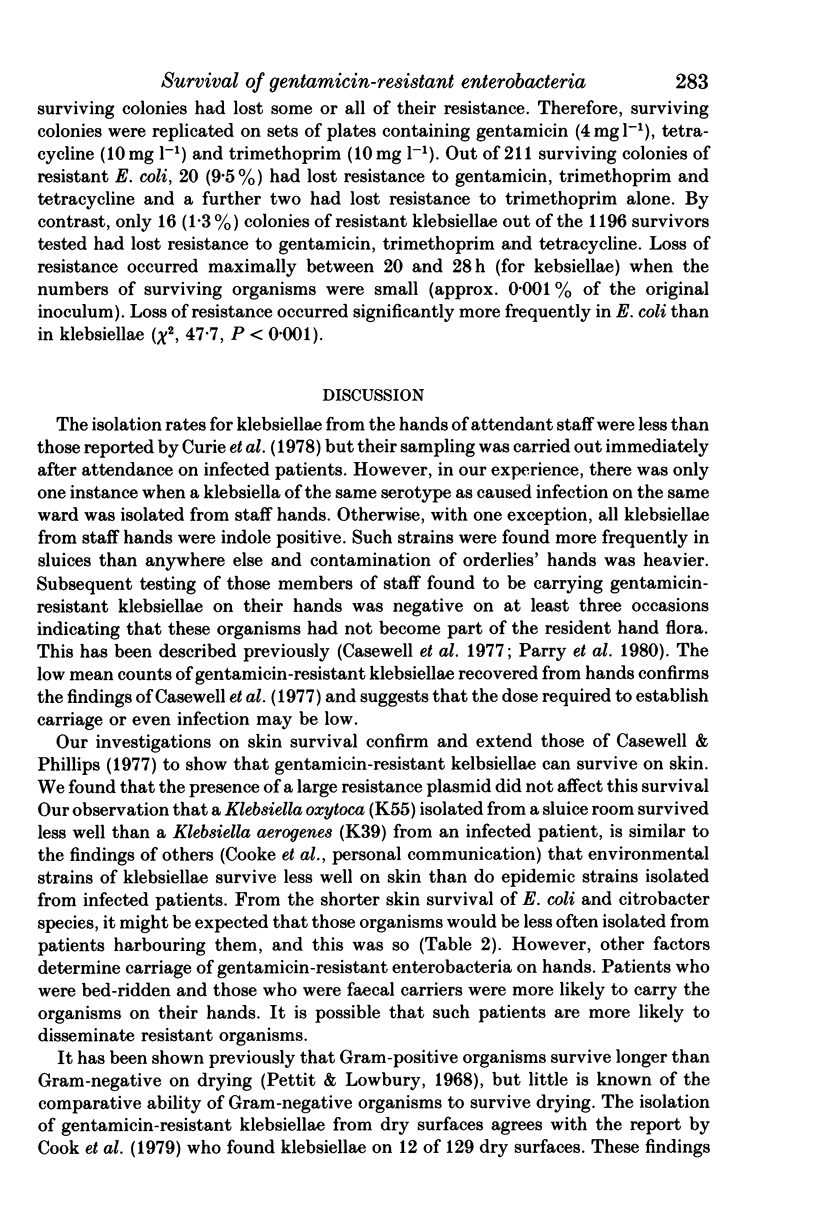Abstract
During a period when 245 patients were infected by or harboured gentamicin-resistant enterobacteria, random sampling showed hand carriage in 33% of affected patients but in only 5% of attendant staff. Only klebsiellae were isolated from the latter. Recovery was commoner from the hands of bed-ridden patients or faecal carriers and significantly more frequent for klebsiellae (37%) and enterobacter (33%) than citrobacter (5.6%) and E. coli (5.0%). Similarly, survival on forearms of volunteers was much longer for klebsiellae and enterobacter than for citrobacter or E. coli (means respectively were 70, 45, 10 and 13 min), and on dry surfaces (means respectively were 28, 26, 3 and 7 h). Klebsiellae were isolated from 17 of the 56 dry environmental surfaces sampled. The presence of plasmid resistance determinants had no effect on survival times, either on the skin or following drying onto formica surfaces. On dry surfaces 9.5% of E. coli but only 1.3% of klebsiellae lost resistance to gentamicin. These findings accord well with recent experience in which gentamicin-resistant klebsiellae have been involved to a much greater extent than other resistant enterobacteria in hospital infection.
Full text
PDF








Selected References
These references are in PubMed. This may not be the complete list of references from this article.
- Casewell M. W., Dalton M. T., Webster M., Phillips I. Gentamicin-resistant Klebsiella aerogenes in a urological ward. Lancet. 1977 Aug 27;2(8035):444–446. doi: 10.1016/s0140-6736(77)90621-3. [DOI] [PubMed] [Google Scholar]
- Casewell M., Phillips I. Food as a source of Klebsiella species for colonisation and infection of intensive care patients. J Clin Pathol. 1978 Sep;31(9):845–849. doi: 10.1136/jcp.31.9.845. [DOI] [PMC free article] [PubMed] [Google Scholar]
- Casewell M., Phillips I. Hands as route of transmission for Klebsiella species. Br Med J. 1977 Nov 19;2(6098):1315–1317. doi: 10.1136/bmj.2.6098.1315. [DOI] [PMC free article] [PubMed] [Google Scholar]
- Cooke E. M., Pool R., Brayson J. C., Edmondson A. S., Munro M. E., Shinebaum R. Further studies on the sources of Klebsiella aerogenes in hospital patients. J Hyg (Lond) 1979 Dec;83(3):391–395. doi: 10.1017/s0022172400026218. [DOI] [PMC free article] [PubMed] [Google Scholar]
- Cox C. S., Baldwin F. The use of phage to study causes of loss of viability of Escherichia coli in aerosols. J Gen Microbiol. 1966 Jul;44(1):15–22. doi: 10.1099/00221287-44-1-15. [DOI] [PubMed] [Google Scholar]
- Curie K., Speller D. C., Simpson R. A., Stephens M., Cooke D. I. A hospital epidemic caused by gentamicin-resistant Klebsiella aerogenes. J Hyg (Lond) 1978 Feb;80(1):115–123. doi: 10.1017/s0022172400053432. [DOI] [PMC free article] [PubMed] [Google Scholar]
- Donovan T. J. A Klebsiella screening medium. J Med Lab Technol. 1966 Jul;23(3):194–197. [PubMed] [Google Scholar]
- Haverkorn M. J., Michel M. F. Nosocomial klebsiellas. II. Transfer in a hospital ward. J Hyg (Lond) 1979 Apr;82(2):195–205. doi: 10.1017/s0022172400025614. [DOI] [PMC free article] [PubMed] [Google Scholar]
- Knittle M. A., Eitzman D. V., Baer H. Role of hand contamination of personnel in the epidemiology of gram-negative nosocomial infections. J Pediatr. 1975 Mar;86(3):433–437. doi: 10.1016/s0022-3476(75)80980-2. [DOI] [PubMed] [Google Scholar]
- Palfreyman J. M. Klebsiella serotyping by counter-current immunoelectrophoresis. J Hyg (Lond) 1978 Oct;81(2):219–225. doi: 10.1017/s0022172400025043. [DOI] [PMC free article] [PubMed] [Google Scholar]
- Parry M. F., Hutchinson J. H., Brown N. A., Wu C. H., Estreller L. Gram-negative sepsis in neonates: a nursery outbreak due to hand carriage of Citrobacter diversus. Pediatrics. 1980 Jun;65(6):1105–1109. [PubMed] [Google Scholar]
- Pettit F., Lowbury E. J. Survival of wound pathogens under different environmental conditions. J Hyg (Lond) 1968 Sep;66(3):393–406. doi: 10.1017/s0022172400041267. [DOI] [PMC free article] [PubMed] [Google Scholar]
- Riser E., Noone P., Howard F. M. Epidemiological study of klebsiella infection in the special care baby unit of a London hospital. J Clin Pathol. 1980 Apr;33(4):400–407. doi: 10.1136/jcp.33.4.400. [DOI] [PMC free article] [PubMed] [Google Scholar]
- Salzman T. C., Clark J. J., Klemm L. Hand contamination of personnel as a mechanism of cross-infection in nosocomial infections with antibiotic-resistant Escherichia coli and Klebsiella-Aerobacter. Antimicrob Agents Chemother (Bethesda) 1967;7:97–100. [PubMed] [Google Scholar]
- Shooter R. A., Cooke E. M., Faiers M. C., Breaden A. L., O'Farrell S. M. Isolation of Escherichia coli, Pseudomonas aeruginosa, and Klebsiella from food in hospitals, canteens, and schools. Lancet. 1971 Aug 21;2(7721):390–392. doi: 10.1016/s0140-6736(71)90111-5. [DOI] [PubMed] [Google Scholar]
- Webb S. J. Effect of dehydration on bacterial recombination. Nature. 1968 Mar 30;217(5135):1231–1234. doi: 10.1038/2171231a0. [DOI] [PubMed] [Google Scholar]


